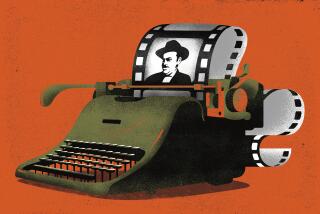‘Citizen Kane’ Gets Digital Face-Lift
- Share via
Orson Welles’ “Citizen Kane,” named the greatest American movie of the 20th century by the American Film Institute, has received a major face-lift after extensive detective work and with the use of the latest digital technology. “Kane,” which celebrates its 60th anniversary this year, looks vibrant and pristine.
“What we tried to accomplish was the theatrical representation of the film as it was originally released,” says Ned Price, vice president of video mastering for Warner Home Video. The restored “Citizen Kane” makes its DVD debut today with a two-disc set ($30).
The DVD includes commentaries from film critic Roger Ebert and from writer-director Peter Bogdanovich, who was a good friend of Welles and has written extensively about him.
It also has footage from the 1941 New York premiere, a gallery of storyboards, rare production photos, call sheets, the original theatrical trailer and “The Battle Over Citizen Kane,” an award-winning PBS documentary chronicling the struggle between Welles and publisher William Randolph Hearst, who claimed the film was a thinly disguised and slanderous account of his life.
Warner is also releasing a new videocassette version of “Kane” ($20) that includes the premiere footage and the trailer.
Welles was just 25 when he moved to Hollywood to make “Citizen Kane” after he and his troupe of actors, the Mercury Players, had won acclaim on Broadway and radio. Welles became an overnight sensation in 1938 with his brilliant and terrifyingly realistic radio adaptation of H.G. Wells’ “The War of the Worlds.”
Just as he had in radio and theater, Welles brought energy and innovation to the film genre with his use of deep-focus cinematography, sound, shadows and nonlinear storytelling.
Penned by Welles and Herman J. Mankiewicz, “Citizen Kane” chronicles the rise and fall of a newspaper publisher, Charles Foster Kane. Everett Sloane, Agnes Moorehead, Ruth Warrick, Joseph Cotten and William Alland also star.
Gregg Toland supplied the indelible black-and-white images and Bernard Herrmann the evocative score. Robert Wise, who would later direct “West Side Story” and “The Sound of Music,” was the movie’s editor.
“Kane” was nominated for several Oscars, including best film, best actor and best director, and it won for Welles’ and Mankiewicz’s screenplay.
When it came time to construct a new print for the DVD, Price says, he and his colleagues had to work from existing prints because the original negative had perished in a fire. The best U.S. print, they were told, belonged to the Museum of Modern Art. The team decided to expand its search.
“We found an additional three or four elements from all around the world, from independent collectors to archives,” Price says. “The good news is that we found a nitrate fine-grain that was much better than the material we had to work with to date. We found it overseas. Between all of these materials, we were able to piece together the rest.”
After restoring the film, Price and his staff did another layer of restoration electronically with a new image-processing computer that gave the film increased resolution.
Price then tackled the complicated audio track. “The original sound material was gone, so we used second-generation elements and we combined several sources,” he says. “The sound was experimental for the time. It was an optical soundtrack, but the format was experimental. It was an early form of noise reduction and track compression.”
In layman’s terms, Price says, “Welles would have something extremely quiet juxtaposed next to something that just really slams you. He kept doing it throughout the entire film. For example, ‘Rosebud,’ in the death scene, is whispered very quietly, and the music falls off dead. The next cut is [the newsreel] ‘News on the March,’ which will literally blow you out of your chair.”
Price wanted to keep Welles’ original intention for the audio track while also taking advantage of the “extra fidelic range” that is available with today’s sophisticated equipment. The first audio mix was tested in a large theater, and it wasn’t quite what he wanted. “We went back and did it again,” he says. “I think we have something successful.”
Bogdanovich finds “great irony, always in this,” of the raising of “Kane” as the greatest film of all time. Because the movie angered the powerful Hearst, “Kane” fell into oblivion for years. “It was blacklisted,” says Bogdanovich. “It didn’t make any money and it disappeared for [nearly] 20 years. It sort of got rediscovered over the years, starting in the ‘50s in France and also in America. I remember it was revived in the mid-’50s in New York.”
There are many confounding aspects to the classic, “in that the film offers an extraordinarily pessimistic, negative view of humanity,” says Bogdanovich. “Yet you don’t come out of the theater feeling down as the story might lead you to feel because it is absolutely an unhappy ending on every level. But because of the extraordinary optimism in the way it is made, there is a kind of tension between the material and the inspiring way in which it is presented.”
More to Read
Only good movies
Get the Indie Focus newsletter, Mark Olsen's weekly guide to the world of cinema.
You may occasionally receive promotional content from the Los Angeles Times.











